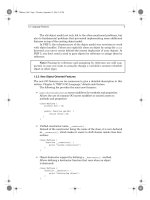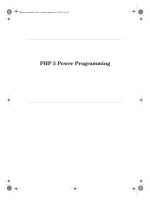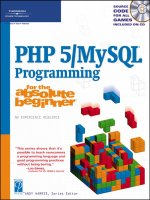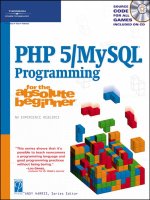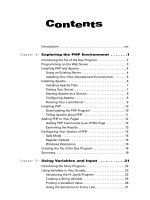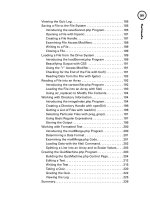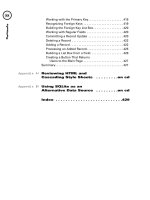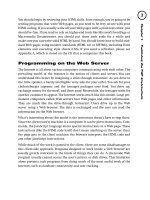PHP 5 Power Programming potx
Bạn đang xem bản rút gọn của tài liệu. Xem và tải ngay bản đầy đủ của tài liệu tại đây (9.39 MB, 720 trang )
PHP 5 Power Programming
Gutmans_Frontmatter Page i Thursday, September 23, 2004 9:05 AM
B
RUCE
P
ERENS
’ O
PEN
S
OURCE
S
ERIES
/>
◆ Java Application Development on Linux
Carl Albing and Michael Schwarz
◆ C++ GUI Programming with Qt 3
Jasmin Blanchette, Mark Summerfield
◆ Managing Linux Systems with Webmin: System Administration and
Module Development
Jamie Cameron
◆ Understanding the Linux Virtual Memory Manager
Mel Gorman
◆ Implementing CIFS: The Common Internet File System
Christopher Hertel
◆ Embedded Software Development with eCos
Anthony Massa
◆ Rapid Application Development with Mozilla
Nigel McFarlane
◆ The Linux Development Platform: Configuring, Using, and Maintaining a
Complete Programming Environment
Rafeeq Ur Rehman, Christopher Paul
◆ Intrusion Detection with SNORT: Advanced IDS Techniques Using SNORT,
Apache, MySQL, PHP, and ACID
Rafeeq Ur Rehman
◆ The Official Samba-3 HOWTO and Reference Guide
John H. Terpstra, Jelmer R. Vernooij, Editors
◆ Samba-3 by Example: Practical Exercises to Successful Deployment
John H. Terpstra
perens_series_7x9.25.fm Page 1 Wednesday, September 15, 2004 10:54 AM
Gutmans_Frontmatter Page ii Thursday, September 23, 2004 9:05 AM
PRENTICE HALL
Professional Technical Reference
Indianapolis, IN 46240
www.phptr.com
PHP 5 Power Programming
Andi Gutmans, Stig Sæther Bakken,
and Derick Rethans
Gutmans_Frontmatter Page iii Thursday, September 23, 2004 9:05 AM
The authors and publisher have taken care in the preparation of this book, but make no expressed or implied
warranty of any kind and assume no responsibility for errors or omissions. No liability is assumed for inciden-
tal or consequential damages in connection with or arising out of the use of the information or programs con-
tained herein.
Publisher:
John Wait
Editor in Chief:
Don O’Hagan
Acquisitions Editor:
Mark L. Taub
Editorial Assistant:
Noreen Regina
Development Editor:
Janet Valade
Marketing Manager:
Robin O'Brien
Cover Designer:
Nina Scuderi
Managing Editor:
Gina Kanouse
Senior Project Editor:
Kristy Hart
Copy Editor:
Specialized Composition
Indexer:
Lisa Stumpf
Senior Compositor:
Gloria Schurick
Manufacturing Buyer:
Dan Uhrig
The publisher offers excellent discounts on this book when ordered in quantity for bulk purchases or special
sales, which may include electronic versions and/or custom covers and content particular to your business,
training goals, marketing focus, and branding interests. For more information, please contact:
U. S. Corporate and Government Sales
(800) 382-3419
c
For sales outside the U. S., please contact:
International Sales
i
Visit us on the Web: www.phptr.com
Library of Congress Cataloging-in-Publication Data:
2004107331
Copyright © 2005 Pearson Education, Inc.
This material may be distrubuted only subject to the terms and conditions set forth in the Open Publication
License, v1.0 or later (the latest version is presently available at />Pearson Education, Inc.
One Lake Street
Upper Saddle River, NJ 07458
Every effort was made to contact and credit all copyright holders. Use of material without proper credit
is unintentional.
ISBN 0-131-47149-X
Text printed in the United States on recycled paper at Phoenix in Hagerstown, Maryland.
First printing, [October 2004]
Gutmans_Frontmatter Page iv Thursday, September 23, 2004 2:14 PM
To Ifat, my wife and best friend, who has patiently put up with my
involement in PHP from the very beginning, and has encouraged
and supported me every step of the way.
Andi Gutmans
To Marianne, for patience and encouragement.
Stig Sæther Bakken
To my parents, who care for me even when I’m not around;
and to 42, the answer to life,
the universe of everything.
Derick Rethans
Gutmans_Frontmatter Page v Thursday, September 23, 2004 9:05 AM
Gutmans_Frontmatter Page vi Thursday, September 23, 2004 9:05 AM
vii
Contents
Foreword by Zeev Suraski
Preface: Introduction and Background
Chapter 1:
What Is New in PHP 5?
Chapter 2:
PHP 5 Basic Language
Chapter 3:
PHP 5 OO Language
Chapter 4:
PHP 5 Advanced OOP and Design Patterns
Chapter 5:
How to Write a Web Application with PHP
Chapter 6:
Databases with PHP 5
Chapter 7:
Error Handling
Chapter 8:
XML with PHP 5
Chapter 9:
Mainstream Extensions
Chapter 10:
Using PEAR
Chapter 11:
Important PEAR Packages
Chapter 12:
Building PEAR Components
Chapter 13:
Making the Move
Chapter 14:
Performance
Chapter 15:
An Introduction to Writing PHP Extensions
Chapter 16:
PHP Shell Scripting
A.
PEAR and PECL Package Index
B.
phpDocumentor Format Reference
C.
Zend Studio Quick Start
Index
Gutmans_Frontmatter Page vii Thursday, September 23, 2004 9:05 AM
Gutmans_Frontmatter Page viii Thursday, September 23, 2004 9:05 AM
ix
Contents
Foreword xxi
Preface xxii
1 What Is New in PHP 5? 1
1.1 Introduction 1
1.2 Language Features 1
1.2.1 New Object-Oriented Model 1
1.2.2 New Object-Oriented Features 3
1.2.3 Other New Language Features 7
1.3 General PHP Changes 8
1.3.1 XML and Web Services 8
1.4 Other New Features in PHP 5 11
1.4.1 New Memory Manager 11
1.4.2 Dropped Support for Windows 95 11
1.5 Summary 11
2 PHP 5 Basic Language 13
2.1 Introduction 13
2.2 HTML Embedding 14
2.3 Comments 14
2.4 Variables 15
2.4.1 Indirect References to Variables 16
2.4.2 Managing Variables 16
2.4.3 Superglobals 18
2.5 Basic Data Types 18
2.5.1 Integers 19
2.5.2 Floating-Point Numbers 19
2.5.3 Strings 19
2.5.4 Booleans 22
2.5.5 Null 23
Gutmans_TOC Page ix Thursday, September 23, 2004 9:06 AM
x Contents
2.5.6 Resources 23
2.5.7 Arrays 23
2.5.8 Constants 30
2.6 Operators 31
2.6.1 Binary Operators 32
2.6.2 Assignment Operators 32
2.6.3 Comparison Operators 33
2.6.4 Logical Operators 34
2.6.5 Bitwise Operators 35
2.6.6 Unary Operators 36
2.6.7 Negation Operators 36
2.6.8 Increment/Decrement Operators 37
2.6.9 The Cast Operators 38
2.6.10 The Silence Operator 39
2.6.11 The One and Only Ternary Operator 39
2.7 Control Structures 39
2.7.1 Conditional Control Structures 39
2.7.2 Loop Control Structures 42
2.7.3 Code Inclusion Control Structures 45
2.8 Functions 48
2.8.1 User-Defined Functions 49
2.8.2 Function Scope 49
2.8.3 Returning Values By Value 50
2.8.4 Returning Values By Reference 51
2.8.5 Declaring Function Parameters 52
2.8.6 Static Variables 53
2.9 Summary 54
3 PHP 5 OO Language 55
3.1 Introduction 55
3.2 Objects 55
3.3 Declaring a Class 57
3.4 The
new
Keyword and Constructors 57
3.5 Destructors 58
3.6 Accessing Methods and Properties Using the
$this
Variable 59
3.6.1
public
,
protected
, and
private
Properties 60
3.6.2
public
,
protected
, and
private
Methods 61
3.6.3 Static Properties 62
3.6.4 Static Methods 64
3.7 Class Constants 65
3.8 Cloning Objects 66
3.9 Polymorphism 67
3.10
parent
:: and
self
:: 70
3.11
instanceof
Operator 71
Gutmans_TOC Page x Thursday, September 23, 2004 9:06 AM
Contents xi
3.12 Abstract Methods and Classes 72
3.13 Interfaces 73
3.14 Inheritance of Interfaces 75
3.15
final
Methods 75
3.16
final
Classes 76
3.17
__toString()
Method 76
3.18 Exception Handling 77
3.19
__autoload()
80
3.20 Class Type Hints in Function Parameters 82
3.21 Summary 83
4 PHP 5 Advanced OOP and Design Patterns 85
4.1 Introduction 85
4.2 Overloading Capabilities 85
4.2.1 Property and Method Overloading 85
4.2.2 Overloading the Array Access Syntax 88
4.3 Iterators 89
4.4 Design Patterns 94
4.4.1 Strategy Pattern 95
4.4.2 Singleton Pattern 97
4.4.3 Factory Pattern 98
4.4.4 Observer Pattern 101
4.5 Reflection 103
4.5.1 Introduction 103
4.5.2 Reflection API 103
4.5.3 Reflection Examples 106
4.5.4 Implementing the Delegation Pattern Using Reflection 107
4.6 Summary 109
5 How to Write a Web Application with PHP 111
5.1 Introduction 111
5.2 Embedding into HTML 112
5.3 User Input 114
5.4 Safe-Handling User Input 117
5.4.1 Common Mistakes 117
5.5 Techniques to Make Scripts “Safe” 120
5.5.1 Input Validation 120
5.5.2 HMAC Verification 122
5.5.3 PEAR::Crypt_HMAC 124
5.5.4 Input Filter 127
5.5.5 Working with Passwords 127
5.5.6 Error Handling 129
5.6 Cookies 131
5.7 Sessions 134
Gutmans_TOC Page xi Thursday, September 23, 2004 9:06 AM
xii Contents
5.8 File Uploads 137
5.8.1 Handling the Incoming Uploaded File 138
5.9 Architecture 143
5.9.1 One Script Serves All 143
5.9.2 One Script per Function 144
5.9.3 Separating Logic from Layout 144
5.10 Summary 146
6 Databases with PHP 5 149
6.1 Introduction 149
6.2 MySQL 149
6.2.1 MySQL Strengths and Weaknesses 150
6.2.2 PHP Interface 150
6.2.3 Example Data 151
6.2.4 Connections 151
6.2.5 Buffered Versus Unbuffered Queries 153
6.2.6 Queries 154
6.2.7 Multi Statements 155
6.2.8 Fetching Modes 156
6.2.9 Prepared Statements 156
6.2.10 BLOB Handling 158
6.3 SQLite 160
6.3.1 SQLite Strengths and Weaknesses 160
6.3.2 Best Areas of Use 161
6.3.3 PHP Interface 162
6.4 PEAR DB 176
6.4.1 Obtaining PEAR DB 176
6.4.2 Pros and Cons of Database Abstraction 177
6.4.3 Which Features Are Abstracted? 177
6.4.4 Database Connections 178
6.4.5 Executing Queries 180
6.4.6 Fetching Results 182
6.4.7 Sequences 184
6.4.8 Portability Features 185
6.4.9 Abstracted Errors 186
6.4.10 Convenience Methods 188
6.5 Summary 190
7 Error Handling 191
7.1 Introduction 191
7.2 Types of Errors 192
7.2.1 Programming Errors 192
7.2.2 Undefined Symbols 194
7.2.3 Portability Errors 197
Gutmans_TOC Page xii Thursday, September 23, 2004 9:06 AM
Contents xiii
7.2.4 Runtime Errors 201
7.2.5 PHP Errors 201
7.3 PEAR Errors 206
7.3.1 The PEAR_Error Class 209
7.3.2 Handling PEAR Errors 212
7.3.3 PEAR Error Modes 213
7.3.4 Graceful Handling 213
7.4 Exceptions 216
7.4.1 What Are Exceptions? 216
7.4.2 try, catch, and throw 216
7.5 Summary 218
8 XML with PHP 5 219
8.1 Introduction 219
8.2 Vocabulary 220
8.3 Parsing XML 222
8.3.1 SAX 222
8.3.2 DOM 226
8.4 SimpleXML 231
8.4.1 Creating a SimpleXML Object 232
8.4.2 Browsing SimpleXML Objects 233
8.4.3 Storing SimpleXML Objects 234
8.5 PEAR 234
8.5.1 XML_Tree 235
8.5.2 XML_RSS 236
8.6 Converting XML 239
8.6.1 XSLT 239
8.7 Communicating with XML 244
8.7.1 XML-RPC 244
8.7.2 SOAP 252
8.8 Summary 259
9 Mainstream Extensions 261
9.1 Introduction 261
9.2 Files and Streams 261
9.2.1 File Access 262
9.2.2 Program Input/Output 264
9.2.3 Input/Output Streams 267
9.2.4 Compression Streams 268
9.2.5 User Streams 270
9.2.6 URL Streams 271
9.2.7 Locking 276
9.2.8 Renaming and Removing Files 277
9.2.9 Temporary Files 278
Gutmans_TOC Page xiii Thursday, September 23, 2004 9:06 AM
xiv Contents
9.3 Regular Expressions 279
9.3.1 Syntax 279
9.3.2 Functions 293
9.4 Date Handling 301
9.4.1 Retrieving Date and Time Information 301
9.4.2 Formatting Date and Time 305
9.4.3 Parsing Date Formats 313
9.5 Graphics Manipulation with GD 314
9.5.1 Case 1: Bot-Proof Submission Forms 315
9.5.2 Case 2: Bar Chart 320
9.5.3
Exif
326
9.6 Multi-Byte Strings and Character Sets 329
9.6.1 Character Set Conversions 330
9.6.2 Extra Functions Dealing with Multi-Byte Character Sets 335
9.6.3 Locales 340
9.7 Summary 343
10 Using PEAR 345
10.1 Introduction 345
10.2 PEAR Concepts 346
10.2.1 Packages 346
10.2.2 Releases 346
10.2.3 Version Numbers 347
10.3 Obtaining PEAR 349
10.3.1 Installing with UNIX / Linux PHP Distribution 350
10.3.2 Installing with PHP Windows Installer 351
10.3.3 go-pear.org 351
10.4 Installing Packages 354
10.4.1 Using the
pear
Command 354
10.5 Configuration Parameters 358
10.6 PEAR Commands 364
10.6.1
pear install
364
10.6.2
pear list
368
10.6.3
pear info
369
10.6.4
pear list-all
370
10.6.5
pear list-upgrades
370
10.6.6
pear upgrade
371
10.6.7
pear upgrade-all
372
10.6.8
pear uninstall
373
10.6.9
pear search
373
10.6.10
pear remote-list
374
10.6.11
pear remote-info
375
10.6.12
pear download
375
10.6.13
pear config-get
376
Gutmans_TOC Page xiv Thursday, September 23, 2004 9:06 AM
Contents xv
10.6.14
pear config-set
376
10.6.15
pear config-show
376
10.6.16 Shortcuts 377
10.7 Installer Front-Ends 378
10.7.1 CLI (Command Line Interface) Installer 378
10.7.2 Gtk Installer 378
10.8 Summary 381
11 Important PEAR Packages 383
11.1 Introduction 383
11.2 Database Queries 383
11.3 Template Systems 383
11.3.1 Template Terminology 384
11.3.2
HTML_Template_IT
384
11.3.3
HTML_Template_Flexy
387
11.4 Authentication 392
11.4.1 Overview 392
11.4.2 Example: Auth with Password File 393
11.4.3 Example: Auth with DB and User Data 394
11.4.4 Auth Security Considerations 396
11.4.5 Auth Scalability Considerations 397
11.4.6 Auth Summary 398
11.5 Form Handling 398
11.5.1
HTML_QuickForm
398
11.5.2 Example: Login Form 399
11.5.3 Receiving Data 399
11.6 Caching 399
11.6.1
Cache_Lite
399
11.7 Summary 401
12 Building PEAR Components 403
12.1 Introduction 403
12.2 PEAR Standards 403
12.2.1 Symbol Naming 403
12.2.2 Indentation 406
12.3 Release Versioning 408
12.4 CLI Environment 408
12.5 Fundamentals 410
12.5.1 When and How to Include Files 410
12.5.2 Error Handling 411
12.6 Building Packages 411
12.6.1 PEAR Example: HelloWorld 411
12.6.2 Building the Tarball 414
12.6.3 Verification 414
12.6.4 Regression Tests 416
Gutmans_TOC Page xv Thursday, September 23, 2004 9:06 AM
xvi Contents
12.7 The package.xml Format 416
12.7.1 Package Information 417
12.7.2 Release Information 419
12.8 Dependencies 423
12.8.1 Element:
<deps>
423
12.8.2 Element:
<dep>
423
12.8.3 Dependency Types 424
12.8.4 Reasons to Avoid Dependencies 425
12.8.5 Optional Dependencies 426
12.8.6 Some Examples 426
12.9 String Substitutions 427
12.9.1 Element:
<replace>
427
12.9.2 Examples 427
12.10 Including C Code 428
12.10.1 Element:
<configureoptions>
428
12.10.2 Element:
<configureoption>
428
12.11 Releasing Packages 428
12.12 The PEAR Release Process 429
12.13 Packaging 430
12.13.1 Source Analysis 430
12.13.2 MD5 Checksum Generation 430
12.13.3 Package.xml Update 431
12.13.4 Tarball Creation 431
12.14 Uploading 432
12.14.1 Upload Release 432
12.14.2 Finished! 432
12.15 Summary 432
13 Making the Move 433
13.1 Introduction 433
13.2 The Object Model 433
13.3 Passing Objects to Functions 433
13.4 Compatibility Mode 435
13.4.1 Casting Objects 435
13.4.2 Comparing Objects 436
13.5 Other Changes 437
13.5.1 Assigning to
$this
437
13.5.2
get_class
440
13.6
E_STRICT
441
13.6.1 Automagically Creating Objects 441
13.6.2
var
and
public
441
13.6.3 Constructors 442
13.6.4 Inherited Methods 442
13.6.5 Define Classes Before Usage 443
Gutmans_TOC Page xvi Thursday, September 23, 2004 9:06 AM
Contents xvii
13.7 Other Compatibility Problems 443
13.7.1 Command-Line Interface 443
13.7.2 Comment Tokens 443
13.7.3 MySQL 445
13.8 Changes in Functions 445
13.8.1
array_merge()
445
13.8.2
strrpos()
and
strripos()
446
13.9 Summary 447
14 Performance 449
14.1 Introduction 449
14.2 Design for Performance 449
14.2.1 PHP Design Tip #1: Beware of State 450
14.2.2 PHP Design Tip #2: Cache! 451
14.2.3 PHP Design Tip #3: Do Not Over Design! 456
14.3 Benchmarking 457
14.3.1 Using ApacheBench 457
14.3.2 Using Siege 458
14.3.3 Testing Versus Real Traffic 459
14.4 Profiling with Zend Studio's Profiler 459
14.5 Profiling with APD 461
14.5.1 Installing APD 461
14.5.2 Analyzing Trace Data 462
14.6 Profiling with Xdebug 465
14.6.1 Installing Xdebug 466
14.6.2 Tracing Script Execution 466
14.6.3 Using KCachegrind 468
14.7 Using APC (Advanced PHP Cache) 470
14.8 Using ZPS (Zend Performance Suite) 470
14.8.1 Automatic Optimization 471
14.8.2 Compiled Code Caching 472
14.8.3 Dynamic Content Caching 473
14.8.4 Content Compression 476
14.9 Optimizing Code 477
14.9.1 Micro-Benchmarks 477
14.9.2 Rewrite in C 479
14.9.3 OO Versus Procedural Code 480
14.10 Summary 481
15 An Introduction to Writing PHP Extensions 483
15.1 Introduction 483
15.2 Quickstart 484
15.2.1 Memory Management 489
15.2.2 Returning Values from PHP Functions 490
15.2.3 Completing self-concat() 490
15.2.4 Summary of Example 492
15.2.5 Wrapping Third-Party Extensions 492
Gutmans_TOC Page xvii Thursday, September 23, 2004 9:06 AM
xviii Contents
15.2.6 Global Variables 501
15.2.7 Adding Custom INI Directives 503
15.2.8 Thread-Safe Resource Manager Macros 504
15.3 Summary 505
16 PHP Shell Scripting 507
16.1 Introduction 507
16.2 PHP CLI Shell Scripts 508
16.2.1 How CLI Differs From CGI 508
16.2.2 The Shell-Scripting Environment 510
16.2.3 Parsing Command-Line Options 512
16.2.4 Good Practices 515
16.2.5 Process Control 516
16.2.6 Examples 520
16.3 Summary 526
A PEAR and PECL Package Index 527
A.1 Authentication 527
A.2 Benchmarking 530
A.3 Caching 530
A.4 Configuration 531
A.5 Console 531
A.6 Database 533
A.7 Date and Time 542
A.8 Encryption 543
A.9 File Formats 545
A.10 File System 548
A.11 Gtk Components 550
A.12 HTML 550
A.13 HTTP 561
A.14 Images 563
A.15 Internationalization 566
A.16 Logging 568
A.17 Mail 569
A.18 Math 571
A.19 Networking 574
A.20 Numbers 584
A.21 Payment 585
A.22 PEAR 587
A.23 PHP 588
A.24 Processing 594
A.25 Science 594
A.26 Streams 595
A.27 Structures 596
A.28 System 598
A.29 Text 599
Gutmans_TOC Page xviii Thursday, September 23, 2004 9:06 AM
Contents xix
A.30 Tools and Utilities 600
A.31 Web Services 603
A.32 XML 604
B phpDocumentor Format Reference 613
B.1 Introduction 613
B.2 Documentation Comments 613
B.3 Tag Reference 615
B.3.1 abstract 615
B.3.2 access 616
B.3.3 author 617
B.3.4 category 618
B.3.5 copyright 618
B.3.6 deprecated 618
B.3.7 example 619
B.3.8 filesource 620
B.3.9 final 620
B.3.10 global 621
B.3.11 ignore 622
B.3.12 inheritdoc (inline) 622
B.3.13 internal, internal (inline) 622
B.3.14 licence 623
B.3.15 link 623
B.3.16 link (inline) 623
B.3.17 name 624
B.3.18 package 624
B.3.19 param 626
B.3.20 return 627
B.3.21 see 627
B.3.22 since 628
B.3.23 static 628
B.3.24 staticvar 629
B.3.25 subpackage 629
B.3.26 todo 630
B.3.27 uses 630
B.3.28 var 631
B.3.29 version 631
B.4 Tag Table 632
B.5 Using the phpDocumentor Tool 633
C Zend Studio Quick Start Guide 643
C.1 Version 3.5.x 643
C.2 About the Zend Studio Client Quick Start Guide 643
C.3 About Zend 643
C.4 Zend Studio Client: Overview 644
Gutmans_TOC Page xix Thursday, September 23, 2004 9:06 AM
xx Contents
C.4.1 Studio Components 644
C.4.2 Client Server Configuration 645
C.4.3 Installation and Registration 645
C.5 Editing a File 647
C.5.1 Editing a File 647
C.6 Working with Projects 648
C.6.1 Advantages of Working with Projects 648
C.6.2 How to Create a Project 648
C.7 Running the Debugger 648
C.7.1 Internal Debugger 649
C.7.2 Remote Debugger 649
C.7.3 Debug URL 650
C.8 Configure Studio Server for Remote Debugger and Profiling 650
C.9 Running the Profiler 651
C.10 Product Support 652
C.10.1 Getting Support 653
C.11 Main Features 653
Index 655
Gutmans_TOC Page xx Thursday, September 23, 2004 9:06 AM
xxi
Foreword
Within the last few years, PHP has grown to be the most widespread web plat-
form in the world, operational in more than a third of the web servers across
the globe. PHP's growth is not only quantitative but also qualitative. More and
more companies, including Fortune companies, rely on PHP to run their busi-
ness-critical applications, which creates new jobs and increases the demand
for PHP developers. Version 5, due to be released in the very near future, holds
an even greater promise.
While the complexity of starting off with PHP remains unchanged and
very low, the features offered by PHP today enable developers to reach far
beyond simple HTML applications. The revised object model allows for large-
scale projects to be written efficiently, using standard object-oriented method-
ologies. New XML support makes PHP the best language available for pro-
cessing XML and, coupled with new SOAP support, an ideal platform for
creating and using Web Services.
This book, written by my colleague, Andi Gutmans, and two very promi-
nent PHP developers, Stig Bakken and Derick Rethans, holds the key to
unlocking the riches of PHP 5. It thoroughly covers all of the features of the
new version, and is a must-have for all PHP developers who are interested in
exploring PHP 5's advanced features.
Zeev Suraski
Gutmans_PrefaceFore Page xxi Thursday, September 23, 2004 9:06 AM
xxii Preface
Preface
“The best security against revolution is in constant correction of abuses and
the introduction of needed improvements. It is the neglect of timely repair
that makes rebuilding necessary.”—Richard Whately
I
N
THE
B
EGINNING
It was eight years ago, when Rasmus Lerdorf first started developing PHP/FI.
He could not have imagined that his creation would eventually lead to the
development of PHP as we know it today, which is being used by millions of
people. The first version of “PHP/FI,” called
Personal Homepage Tools/
Form Interpreter,
was a collection of Perl scripts in 1995.
1
One of the basic
features was a Perl-like language for handling form submissions, but it lacked
many common useful language features, such as
for
loops.
1
/>
Gutmans_PrefaceFore Page xxii Thursday, September 23, 2004 9:06 AM
In the Beginning xxiii
PHP/FI 2
A rewrite came with PHP/FI 2
2
in 1997, but at that time the development was
almost solely handled by Rasmus. After its release in November of that year,
Andi Gutmans and Zeev Suraski bumped into PHP/FI while looking for a lan-
guage to develop an e-commerce solution as a university project. They discov-
ered that PHP/FI was not quite as powerful as it seemed, and its language was
lacking many common features. One of the most interesting aspects included
the way
while
loops were implemented. The hand-crafted lexical scanner would
go through the script and when it hit the while keyword it would remember its
position in the file. At the end of the loop, the file pointer sought back to the
saved position, and the whole loop was reread and re-executed.
PHP 3
Zeev and Andi decided to completely rewrite the scripting language. They then
teamed up with Rasmus to release PHP 3, and along also came a new name: PHP:
Hypertext Preprocessor, to emphasize that PHP was a different product and not
only suitable for personal use. Zeev and Andi had also designed and implemented
a new extension API. This new API made it possible to easily support additional
extensions for performing tasks such as accessing databases, spell checkers and
other technologies, which attracted many developers who were not part of the
“core” group to join and contribute to the PHP project. At the time of PHP 3’s
release
3
in June 1998, the estimated PHP installed base consisted of about 50,000
domains. PHP 3 sparked the beginning of PHP’s real breakthrough, and was the
first version to have an installed base of more than one million domains.
PHP 4
In late 1998, Zeev and Andi looked back at their work in PHP 3 and felt they
could have written the scripting language even better, so they started yet
another rewrite. While PHP 3 still continuously parsed the scripts while execut-
ing them, PHP 4 came with a new paradigm of “compile first, execute later.” The
compilation step does not compile PHP scripts into machine code; it instead
compiles them into byte code, which is then executed by the
Zend Engine
(Zend stands for
Ze
ev & A
nd
i), the new heart of PHP 4. Because of this new
way of executing scripts, the performance of PHP 4 was much better than that
of PHP 3, with only a small amount of backward compatibility breakage
4
.
Among other improvements was an improved extension API for better run-time
performance, a web server abstraction layer allowing PHP 4 to run on most pop-
ular web servers, and lots more. PHP 4 was officially released on May 22, 2002,
and today its installed base has surpassed 15 million domains.
2
/>
3
317675I-
100000%40shell.lerdorf.on.ca.
4
/>
Gutmans_PrefaceFore Page xxiii Thursday, September 23, 2004 9:06 AM
xxiv Preface
In PHP 3, the minor version number (the middle digit) was never used,
and all versions were numbered as 3.0.x. This changed in PHP 4, and the minor
version number was used to denote important changes in the language. The first
important change came in PHP 4.1.0,
5
which introduced
superglobals
such as
$_GET
and
$_POST
. Superglobals can be accessed from within functions without
having to use the
global
keyword. This feature was added in order to allow the
register_globals
INI option to be turned off.
register_globals
is a feature in
PHP which automatically converts input variables like
"?foo=bar" in http://
php.net/?foo=bar
to a PHP variable called
$foo
. Because many people do not
check input variables properly, many applications had security holes, which
made it quite easy to circumvent security and authentication code.
With the new superglobals in place, on April 22, 2002, PHP 4.2.0 was
released with the
register_globals
turned off by default. PHP 4.3.0, the last
significant PHP 4 version, was released on December 27, 2002. This version
introduced the
Command Line Interface
(CLI), a revamped file and net-
work I/O layer (called
streams
), and a bundled GD library. Although most of
those additions have no real effect on end users, the major version was
bumped due to the major changes in PHP’s core.
PHP 5
Soon after, the demand for more common object-oriented features increased
immensely, and Andi came up with the idea of rewriting the objected-oriented
part of the Zend Engine. Zeev and Andi wrote the “Zend Engine II: Feature
Overview and Design” document
6
and jumpstarted heated discussions about
PHP’s future. Although the basic language has stayed the same, many fea-
tures were added, dropped, and changed by the time PHP 5 matured. For
example, namespaces and multiple inheritance, which were mentioned in the
original document, never made it into PHP 5. Multiple inheritance was
dropped in favor of interfaces, and namespaces were dropped completely. You
can find a full list of new features in Chapter, “What Is New in PHP 5?”
PHP 5 is expected to maintain and even increase PHP’s leadership in
the web development market. Not only does it revolutionizes PHP’s object-
oriented support but it also contains many new features which make it the
ultimate web development platform. The rewritten XML functionality in
PHP 5 puts it on par with other web technologies in some areas and over-
takes them in others, especially due to the new SimpleXML extension which
makes it ridiculously easy to manipulate XML documents. In addition, the
new SOAP, MySQLi, and variety of other extensions are significant mile-
stones in PHP’s support for additional technologies.
5
/>
6
/>
Gutmans_PrefaceFore Page xxiv Thursday, September 23, 2004 9:06 AM
Audience xxv
A
UDIENCE
This book is an introduction to the advanced features new to PHP 5. It is writ-
ten for PHP programmers who are making the move to PHP 5. Although
Chapter 2, “PHP 5 Basic Language,” contains an introduction to PHP 5 syn-
tax, it is meant as a refresher for PHP programmers and not as a tutorial for
new programmers. However, web developers with experience programming
other high-level languages may indeed find that this tutorial is all they need
in order to begin working effectively with PHP 5.
C
HAPTER
O
VERVIEW
Chapter 1, “What Is New in PHP 5?” discusses the new features in PHP 5.
Most of these new features deal with new object-oriented features, including
small examples for each feature. It also gives an overview of the new exten-
sions in PHP 5. Most of the topics mentioned in this chapter are explained in
more detail in later chapters.
Chapter 2, “PHP 5 Basic Language,” introduces the PHP syntax to those
readers not familiar with PHP. All basic language constructs and variable
types are explained along with simple examples to give the reader the neces-
sary building blocks to build real scripts.
Chapter 3, “PHP 5 OO Language,” continues exploring PHP 5's syntax,
focusing on its object-oriented functionality. This chapter covers basics, such
as properties and methods, and progresses to more complicated subjects, such
as polymorphism, interfaces, exceptions, and lots more.
Using the previous chapter as a foundation, Chapter 4, “PHP 5 Advanced
OOP and Design Patterns,” covers some of the most advanced features of PHP
5’s object model. After learning these features, including four commonly used
design patterns and PHP’s reflection capabilities, you will soon become an OO
wizard.
Now that you are familiar with the syntax and language features of PHP,
Chapter 5, “How to Write a Web Application with PHP,” introduces you to the
world of writing web applications. The authors show you basics, such as han-
dling input through form variables and safety techniques, but this chapter
also includes more advanced topics, such as handling sessions with cookies
and PHP's session extension. You also find a few tips on laying out your source
code for your web applications.
Chapter 6, “Databases with PHP 5,” introduces using MySQL, SQLite,
and Oracle from PHP, but focuses primarily on the PHP 5-specific details of
database access. For each database, you learn about some of its strong and
weak points, as well as the types of applications at which each excels. And of
course, you learn how to interface with them using PHP's native functions or
using PEAR DB.
Gutmans_PrefaceFore Page xxv Thursday, September 23, 2004 9:06 AM
